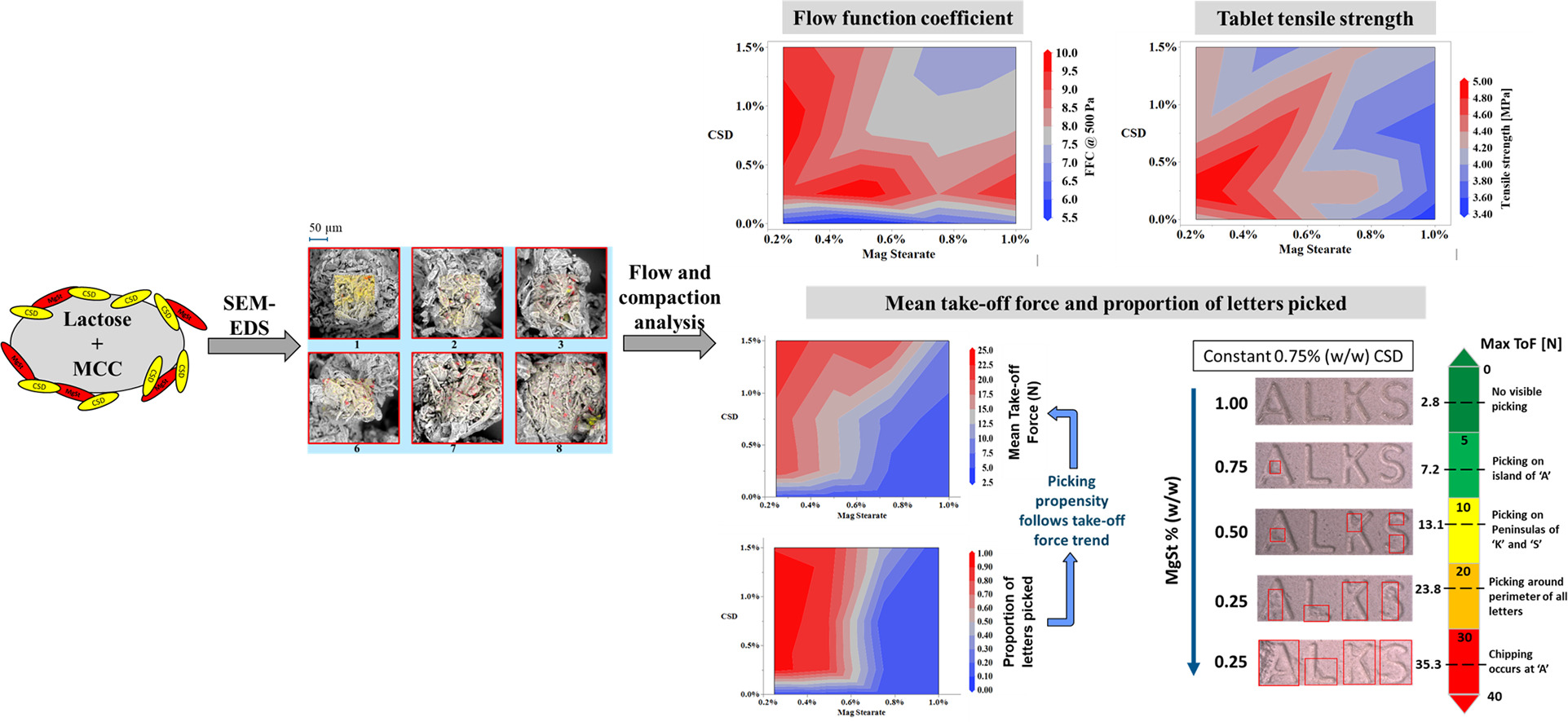Influence of colloidal silicon dioxide‑magnesium stearate interaction on flow and compaction behavior of an MCC-Lactose binary mixture

Abstract
The amount of glidant and lubricant in a tablet formulation is driven by their primary functionalities of enhancing flowability and reducing particle-wall friction. However, their interaction can lead to undesirable outcomes. This study has examined the influence of this interaction on powder flow and compaction, using colloidal silicon dioxide as a glidant and magnesium stearate as a lubricant in a 50:50 w/w MCC:Lactose binary blend. The findings suggest that nano-sized CSD particles coat other particles in a blend. However, increasing CSD decreases exposed MgSt and reduces its lubricity, resulting in intriguing powder flow and compaction phenomena. CSD impacts powder flow more than MgSt. Increasing the CSD reduces exposed MgSt and increases particle-wall adhesion. Higher CSD concentrations decreased powder bed bulk density and permeability due to the formation of porous structures on primary host particles. A complex interplay between CSD and MgSt during tablet compaction affected tensile strength. CSD promoted tablet picking due to reduced exposed MgSt and increased tablet-punch adhesion. This is the first study correlating tablet picking with take-off force, and it was found that >5 N take-off force risked picking. Ejection force increased with CSD and decreased with MgSt, reaffirming CSD’s impact on particle-wall adhesion.
Introduction
A robust pharmaceutical powder formulation is essential for tablet compression to ensure high drug product quality and uninterrupted manufacturing processes [1]. A typical pharmaceutical formulation is a heterogeneous mixture of various components, including binders, diluents, glidants, lubricants, disintegrants, and one or more active pharmaceutical ingredients. Each of these components within the formulation plays a crucial role in defining the robustness and overall quality of the final drug product. An appropriate amount of each component is needed in the formulation to achieve the desired drug product characteristics. For instance, a plastic binder like microcrystalline cellulose (MCC) is often mixed with a brittle diluent such as monohydrate lactose. This combination ensures that the resulting tablets have sufficient strength while maintaining optimal disintegration properties [2]. In many tablet formulations, especially for API with high potency that have low API concentration, excipients form a major portion of the formulation. In such scenarios, these excipients play a major role in governing the flow and compaction behavior of the formulation for the high-speed tableting process. While multiple studies have investigated the effect of some of these blend components on powder compaction and flow, the interaction of glidant and lubricant, which is the lubrication inhibition behavior of glidant on lubricant, has yet to be exhaustively investigated.
A glidant, such as nano-sized colloidal silicon dioxide (CSD) in a formulation, aids the flowability of powder mixtures and has been a longstanding pharmaceutical excipient for a direct compression tableting process [3,4]. These glidant nanoparticles adhere to the surface of the host particle through van der Waals forces [5] and reduce inter-particle cohesion by increasing the separation between contact points among host particles [[6], [7], [8]]. The impact of CSD on powder flow has been investigated, and concentration ranges for its optimal use have been established based on dynamic and static flow tests [[9], [10], [11], [12]]. Notably, the improvement in powder flowability is also reflected in the die-filling efficiency, which showed a significant improvement with the addition of a small amount of CSD [13]. However, the optimal glidant amount depends on mixing conditions and host particle morphology [14]. In a prior study, the optimal CSD amount was determined to be 0.25% under gentle and 0.125% under strong mixing conditions, and the glidant particles adhered preferentially to MCC Avicel PH 101 over Starch 1500. Beyond its influence on powder flow, CSD also affects powder compaction by improving tablet strength across multiple mixing methods [15] depending on the CSD surface treatment [16]. Moreover, the moisture level of CSD was found to cause tablet defects like picking and sticking [17].
Besides glidants, lubricants are commonly used in pharmaceutical powder formulations to reduce tablet-punch adhesion [18,19], tablet-die wall friction [[19], [20], [21], [22]], and minimize adhesion between particles [23,24]. Magnesium stearate (MgSt) is the most common lubricant in pharmaceutical formulations [[25], [26], [27], [28]]. Characterized by micro-sized, thin plate-shaped particles, MgSt effectively coats larger host particles. Previous SEM studies have revealed that MgSt tends to sit on a particle surface as discrete aggregates rather than forming a continuous thin film [29]. Further insights from atomic force microscopy have demonstrated a stronger affinity of MgSt particles for steel surfaces than MCC, effectively preventing MCC particles from sticking to the steel surface [30]. However, MgSt hinders particle-particle bonding during compaction, weakening the tablet. The extent to which MgSt evenly distributes on the surface of host particles increases with mixing and can further reduce tablet strength [31,32] and increase tablet brittleness [33]. MgSt was also shown to form a eutectic mixture with ibuprofen, lowering the melting point and increasing the sticking propensity when added at higher concentrations [34]. Given these intricate dynamics, determining the optimal MgSt amount in the formulation becomes critical in ensuring a robust tablet manufacturing process.
Many a time, both the glidant and lubricant are used together in a formulation. In such a scenario, it becomes essential to understand the lubrication inhibition behavior (referred here as glidant-lubricant interaction) of glidant and how it affects the flow and compression behavior of blends. Powder flow can be impacted by the CSD and MgSt order of addition, as CSD is known to influence the magnesium stearate spread on the particle surface and its lubrication efficiency [35,36]. The ingredient that is added first coats the host particle, while the ingredient added last would have a higher probability of staying on the outside. Adding CSD first led to better powder flow and die-filling efficiency than adding MgSt first [37]. The lubrication efficiency of MgSt was dependent on the concentration of CSD in the formulation; this lack of lubricity manifests itself as picking in the tablets [38]. The complexity of glidant-lubricant interaction behavior means that it is beneficial to determine the levels of these components and understand their interaction at the early stages of formulation. Employing material-sparing approaches at this stage can prove beneficial in understanding this complex relationship effectively using a minimal amount of material.
A compaction simulator stands out as a widely utilized material-sparing tool in the formulation and process development of powder compression due to its flexibility and customized instrumentation capabilities like take-off and ejection forces measurement [39]. Although take-off forces didn’t correlate with the sticking tendency of tablets with a flat-faced punch without embossment [40,41], they do become important in predicting the picking tendency around tablet debossing, as evidenced by findings from the current study. Additionally, the ejection force provides a quantifiable means to evaluate the reduction of lubrication efficiency of MgSt due to the presence of CSD.
Despite the significance of the CSD-MgSt interaction on powder flow and compression behavior, limited attention has been directed toward this topic. This study has tried to develop a more mechanistic understanding of the CSD-MgSt interaction. In this study, a design of experiment approach was used to assess the influence of CSD-MgSt interaction on powder flow and compression of a 50:50 (w/w) binary mixture of MCC and Lactose. SEM-EDS imaging was performed to understand the mechanism of CSD-MgSt interaction and its spread on primary particles. The powder flow assessments were performed on the Schulze’s ring shear tester and Freeman FT4 rheometer. Tablets were manufactured on a Huxley Bertram HB100 compaction simulator. The HB100 can measure the impact of CSD-MgSt interaction on the take-off and ejection forces of tablets. This study shows a close relationship between tablet-picking behavior and take-off force. This finding offers novel avenues for formulators to predict picking on a material-sparing compaction simulator without the need to perform a large-scale tablet press run. Finally, the comprehensive understanding of CSD-MgSt interaction from this study can guide in choosing the optimal amount. Some limitations of this study are: (i) it doesn’t include an API in the model formulation, and (ii) any CSD-MgSt chemical interaction was not considered.
Read more here
Rohit Kumar, Sam Wagoner, Jonathan Cummings, Evangelia Tsolaki, Mark A. Oliveira, Zelalem A. Worku, Renato A. Chiarella, Influence of colloidal silicon dioxide‑magnesium stearate interaction on flow and compaction behavior of an MCC-Lactose binary mixture, Powder Technology, Volume 434, 2024, 119371, ISSN 0032-5910, https://doi.org/10.1016/j.powtec.2024.119371.
Read more on “Magnesium Stearate as a pharmaceutical excipient” here:


